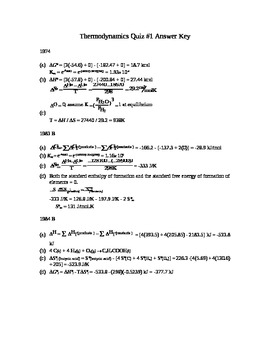
Internal energy of the gas is used in doing work.ġ1. Law of conservation of energy is inapplicable.Įnergy is needed and comes from the wall of the gas’s container. What happens when a gas expands adiabatically? The work done in an adiabatic change in a gas solely depends on –ġ0. The amount of work required to cool down the vessel is –ĩ. The specific heat capacity of metal at low temperature (T) isĪ 100-gram vessel of this metal is to be cooled down from 20 K to 4 K by a particular refrigerator functioning at home temperature (27 K). Which process results in the maximum work done on the gas?Ĩ. An ideal gas is compressed to half of its initial volume by several processes. 1 mole of an ideal diatomic gas passes through a transition from A to B along the path AB.ĭuring the transition, what is the change in internal energy of the gas?ħ. Calculate the temperature of the surrounding where it releases heat.Ħ. If the temperature inside said refrigerator is -20⁰ C. The coefficient of performance of a refrigerator is 5. Calculate the amount of energy absorbed at lower temperature from the reservoir.Ī reversible cycle is more efficient than irreversible one.Ĭarnot cycle is the most efficient among all cycles.Īll reversible cycle has same efficiency.ĥ. A Carnot engine, containing efficiency of ɳ=1/10 as heat engine and used as a refrigerator. (Assume the gas to be close to ideal gas)ģ. Helium gas passes through a cycle ABCDA (containing two isobaric and isochoric lines) shown in the fig. “Heat cannot by itself flow from a body at a lower temperature to a body at a higher temperature”- the statement is which of the following?Ģ. It has four fundamental laws.įollowing are a Few Vital Thermodynamics MCQ Collated for Your Convenience.ġ. Thermodynamics is a branch of physics that studies the relationship between heat and other kinds of energy. As a matter of fact, a total of 45 questions will be asked from Physics. Hence, learn the section minutely followed by solving thermodynamics mcq for a complete grasp on the topic.Īlong with that also take a glance at previous years’ thermodynamics NEET questions for a better understanding of the question pattern. Thermodynamics is one of the chapters from which 5 to 10 questions are asked each year. Therefore, if you are an NEET aspirant, you must have a clear idea about chapter-wise weightage. In National Eligibility cum Entrance Test (NEET), physics plays a crucial role as this paper carries 180 marks. The main disadvantage of flywheels is that they can explode at any second because the wheel inside is spinning so fast.Important Physics NEET MCQs On Thermodynamics Flywheels were also used in steam engines of the 1970's. In the 1950's, flywheel powered buses were used in Yverdon, Switzerland. Flywheels are not affected by the weather like chemical batteries, and do not hurt the environment. They are lightweight, reliable and have a ninety-five percent power efficiency.

Only a few terajoules were used to power astronauts to the moon and back.įlywheels can charge in fifteen minutes, and do not need maintenance for twenty years. It takes about 30,000 joules to make a cup of tea. A terajoule is equal to a thousand billion joules. If scientists could make even stronger material, then someday flywheels could hold many terajoules of energy. Speed is everything: the faster the flywheel can go, the more power it can store. The concentric wheel is made of high-tensile-strength fibers embedded in epoxy resins. A flywheel's spinning wheel is levitated by a magnet inside a vacuum, which reduces almost all friction. This question was created by Phoenix Rising team member pollucci19.įlywheels store energy as kinetic-mechanical energy. In this example of a struck match, the excess energy is converted into heat. In other words, the extra energy cannot simply disappear or be destroyed.

This is in accordance with the First Law of Thermodynamics which states that "energy cannot be created or destroyed, merely changed from one form to another". The energy contained in the new bond is less than the energy obtained from striking the match and, as a result, heat is given off. Striking it provides the energy that re-arranges the atoms of the chemicals to create a new bond, thereby forming a new molecule. The chemicals in the matchhead and the striking surface represent the old bonds. It involves the breaking of a bond to create a new bond and if the energy that is needed to break the old bond is more than the energy in the new bond then that surplus energy is released to the surrounding areas as heat.Ī good example is a match being struck. An exothermic reaction can be either physical or chemical.


 0 kommentar(er)
0 kommentar(er)
